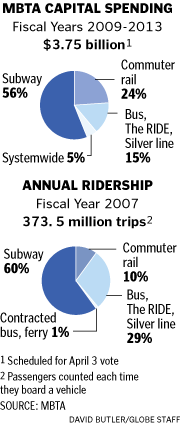statler
Senior Member
- Joined
- May 25, 2006
- Messages
- 7,938
- Reaction score
- 543
Boston Globe - March 26

Amid woes, T expects to spend mightily
Plans $562m to expand, add rail cars over 5 years
By Noah Bierman, Globe Staff | March 25, 2008
The MBTA expects to spend $562 million in the next five years for new Orange Line and commuter rail cars and a planned expansion of its Silver Line bus service.
The improvements are part of a $3.75 billion capital investment program expected to be approved April 3 by the board of the Massachusetts Bay Transportation Authority.
The MBTA updates its 5-year repair and expansion plan annually. But the latest update is being considered as the T is struggling mightily, digging into rainy day funds to meet its daily operational expenses, as it manages $8.2 billion in debt and interest payments.
To pay for the repairs, new garages, new rail cars, and the rest, the T will rely mostly on a combination of federal grants and heavy borrowing. That means that the T's debt will grow by $1.33 billion in the five years of the plan.
Yet transit advocates and the T's management say the agency risks losing riders to unreliable service if it does not spend to repair and replace equipment.
"Most of it, you would refer to it as needed improvements," said Eric Bourassa, a transportation policy analyst for the Massachusetts Public Interest Research Group. "If you don't fix these things or do these things, it's going to break. And the system's not going to work."
Expansion projects such as the Silver Line extension, an airport tunnel planned along Boylston Street, make up less than 5 percent of the 5-year budget.
The $81.5 million for the Silver Line expansion would go toward planning and design, not construction. Some of that money could be withdrawn if the federal government decides not to fund its share of the $1.1 billion project.
Other projects will not be as obvious to commuters: a $209 million Arborway bus garage; $17.7 million for tunnel inspection; $26 million to rehabilitate bridges; and $22 million to add elevators and other accessibility upgrades to the Science Park station.
"If we didn't spend, we would simply be deferring maintenance and, in many cases, not making the investments that our existing riders want and our potential new riders want," Daniel A. Grabauskas, MBTA general manager, said in a phone interview.
The MBTA plans to begin rolling out new Orange Line cars in 2016, three years after the five-year plan expires.
Grabauskas put most of the money for the new cars at the end of the current plan, to signal the new priority as the T finishes replacing the aging Green and Blue fleets.
Existing Orange line cars began running between 1979 and 1981. Replacing the entire 140-car Orange fleet will cost far more than the $80 million set aside, though Grabauskas does not yet know how much. New Blue line cars cost $173 million, and that fleet is smaller. Grabauskas said he has to delay a lot of the T's needs, moving spending into future years, because the money is not there to do everything right away.
"Do our needs outstrip what we spend every year? The answer is absolutely, yes," he said.
But the longer that needs are put off, the more expensive the projects become. Last year, the T budgeted $120 million to buy 38 new locomotives for the commuter rail service. Now, as the project draws closer, the price has gone up by $66 million for 10 fewer locomotives.
Grabauskas expects the 28 new locomotives and the $217 million 75 bilevel coaches to arrive during the next three years.
The 5-year plan also includes new ridership numbers, the first annual accounting since the T raised fares in January 2007. Despite the hike, the T did not lose riders last year. Daily ridership on buses, trains, ferries, and subways went from 1,118,071 trips in 2006 to 1,241,631 trips last year.
Although nearly 30 percent of the T's riders use buses, the vehicles get only 15 percent of the money in the 5-year plan. Grabauskas said the T has been replacing a third of the bus fleet last year and this year and has spent more than $1.6 billion on bus upgrades over the past seven years.
Still, bus riders say they have not received their fair share as the T spends relatively more money on commuter rail that largely serves the suburbs.
"We should receive more than 12 percent of the budget," said Lee Matsueda, an organizer with the MBTA Riders Union. "People in these communities have to rely on public transit."

